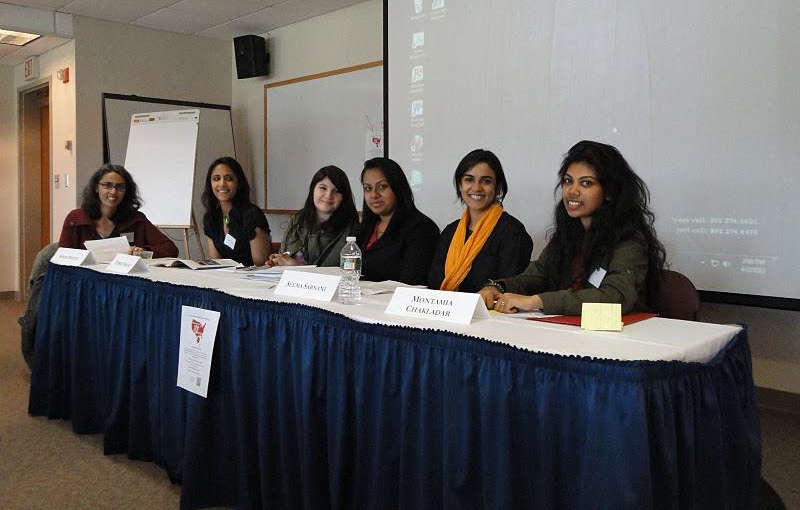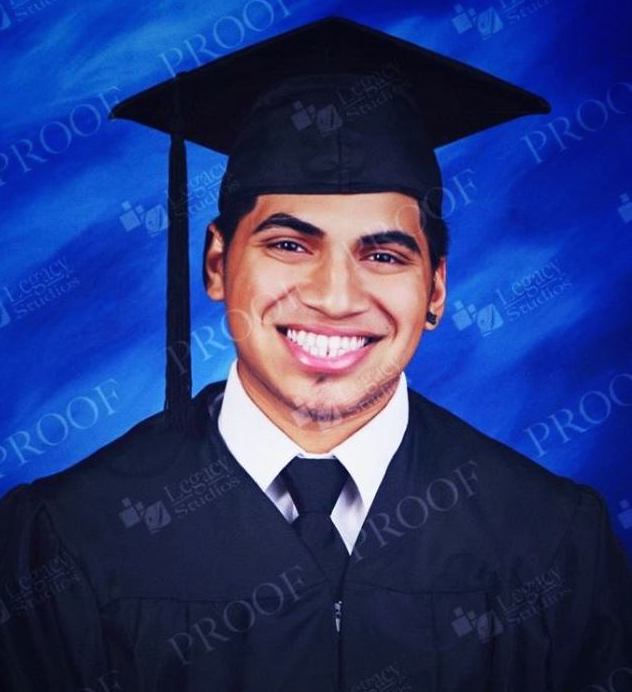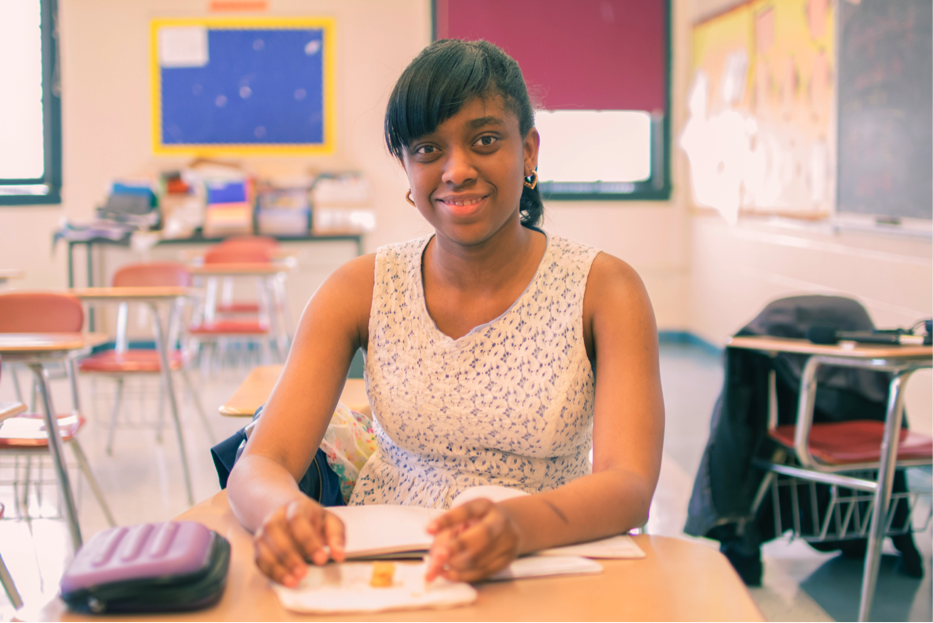
Somebody had forgotten to close a window in the second-floor classroom at Richmond Hill High in Queens. Ten students, shivering on a cold Monday afternoon in February, pushed their desks into an amoebic cluster, the screech of metal chair legs resounding down the hall.
Sixteen-year-old Rosie , keeping warm in her tight pink jacket and studded belt, wrote on the blackboard: “Leadership Session: A place to speak your mind.”
At first glance, it was hard to pinpoint the leaders of the circle. Eighteen-year-old Amanda Seecharan, a leadership coordinator at South Asian Youth Action sat at one of the desks like the rest of the students. Her round face and purple T-shirt didn’t give away her authority, until she raised her voice to for attention. Her co-leader, Jenny Hernandez, looked equally young.
Just last year, Seecharan was a senior at Richmond Hill, and a participant in this 15-year-old nonprofit organization based in Elmhurst. The youth action group works with schools to get teens involved through discussions, service and field trips. While it targets South Asians — often immigrant children from India, Bangladesh or Sri Lanka — its members can include other ethnicities in lower to middle-income families.
While Seecharan credits the organization for turning her young life around, she sees herself slowly pulling away from it now, finding new ways of working with youth in her community and discovering more about herself.
On that Monday at Richmond Hill, Seecharan was meeting with her SAYA leadership class, this time to talk about sex education. The students were loud, making jokes about oral sex, and texting, even though she told them to put their phones away. She roped in the noise: “You know the drill, guys, let’s check in.”
Roberto, a pleasant-faced boy with a checkered shirt and flat-brimmed baseball cap, began the roll call of personal issues: “Today I finally got my phone back from the teacher,” he said. “Ten days, man.”
Other students chimed:
“My mom’s in the hospital,” said a young Latina girl with tightly wound curls.
“I was annoyed all day long,” said the next girl, crossing her arms and staring at the boy next to her.
“My new sneakers have leopard print,” he joked, oblivious to her glare.
And then a girl in low-slung black Dickies and a graphic T-shirt surprised everyone: “For the record, I was not drunk on Friday night — I was drinking, but not drunk.” She paused as her friends got loud, oscillating between a self-conscious grin and a defiant smirk. “And I want you guys to know I remember everything I said, and I meant it.”
“You shouldn’t be saying that in here,” said Seecharan, reminding her that they were still in a school atmosphere. She grew up in the same Richmond Hill neighborhood, which is wedged between Jamaica and Far Rockaway, and knows about the underlying drug problems that plague the working class community of mostly West Indian and Black families.
Born to a Trinidadian father and Puerto Rican mother, Seecharan switches fluidly between Spanish and English, a skill that prevents Latino students in her classes from getting away with anything. Her wavy black hair and features are Indian, an indication of Trinidad’s cultural makeup. She thinks of Puerto Rico as her real home, and counts the days until she visits this summer. But summer’s not here yet — she has her own education to deal with, and the paths of at least 100 other students.
“They come in here with a lot, and I get that. That’s why they know they can talk to me about whatever they want,” she said, recounting stories of alcoholic fathers and girls feeling the pressure from their boyfriends.
Seecharan’s own introduction to SAYA happened casually, at least on her part, during her sophomore year of high school, when she joined one of the organization’s digital photography classes because she liked art and wanted to try something new. Within months she met Seema Sabrani, a woman who would become her strongest mentor and guide.
“Who I was, and who I am now, is a whole 180-degree difference,” she said.
Who she was, Seecharan explained, was not a bad kid, but rather one without direction. Her home life was stable — her mother is a social worker and her father works at JFK airport. At school, Seecharan would get 70 percent on tests, hang out with friends, and talk about the usual boy troubles and weekend plans. She didn’t stop to think much about what SAYA would come to propose — a strong sense of self and learning how to take action.
For the next three years, Seecharan remained active in SAYA, interning with the staff and participating in a program for young entrepreneurs. Suddenly she found herself in a new world, from starting an anti-litter campaign at school to speaking with government officials about the Dream Act, a federal policy focused on getting undocumented immigrant students into college.
After graduation, Seecharan joined John Jay College of Criminal Justice at the City University of New York, working toward her goal of becoming a homicide investigator. A few months later, she said trouble with her financial aid forced her to transfer to LaGuardia Community College, where she is now, with the intention of returning to John Jay.
“I like solving puzzles and being in the community and [the TV show] Criminal Minds,” she said of her dream career. “And I can’t see myself sitting at a desk.”
With her own college career just beginning, it’s sometimes hard to be a teacher or mentor to students who were just friends one year ago. Knowing this, the students sometimes test her, joking just enough to push her patience and speaking a little too intimately about their boyfriends. Even so, the students ask her permission to use the bathroom or get snacks.
“Amanda is kind, patient, loving, caring, wonderful, nice, supportive and like a sister,” said her student Brad, who is toting a guitar and sauntering down the halls with a shy girl.
“Oh come on, tell her the truth. You know I call you out, you know I yell,” Seecharan said laughing.
“It’s true,” he insisted.
“He’s lying, I can be a bit of a hard ass,” Seecharan said. “But it’s okay, how can you not love ‘em?”
When it comes to her students — over 150 of them — it’s clear she does, in fact, love ‘em. She couldn’t decide on a favorite moment, between train rides with her students, ice skating at Bryant Park or getting lost in Manhattan during a field trip. Or a favorite student — the girl from the all girls group, the boy who is “such an amazing dancer, like ‘Americas Got Talent’ amazing,” or Roberto, who thinks of her as an older sister.
Seecharan’s relationship with SAYA, however, is about to end, a change that she sees as necessary and inevitable. The organization, she said, has changed. She couldn’t put her finger on it, but said the atmosphere and the people are not the same as what she entered three years ago. “But I know that I don’t need them to make a difference, and I think that’s a good thing.”
She also said there is no doubt that students will keep in touch well past the Richmond Hill High School hallways, as they have in the past, dubbing her ‘Mom’ and calling her about college woes and excitement. As the end of the semester gets closer and more real, she knows she will remain a mentor, as Sabrani has for her, and will be involved in her community in some way.
“I was just telling Jenny over Presidents Weekend — the extra day was too long. I missed my kids. I missed their faces.”



